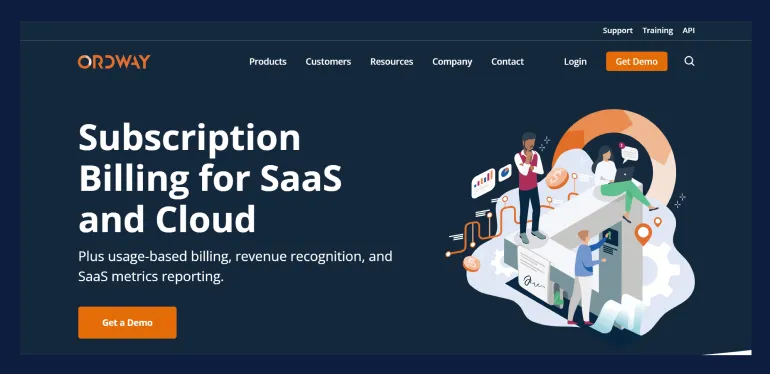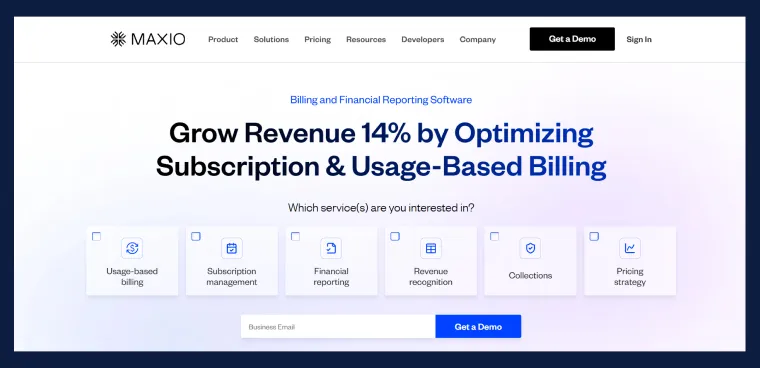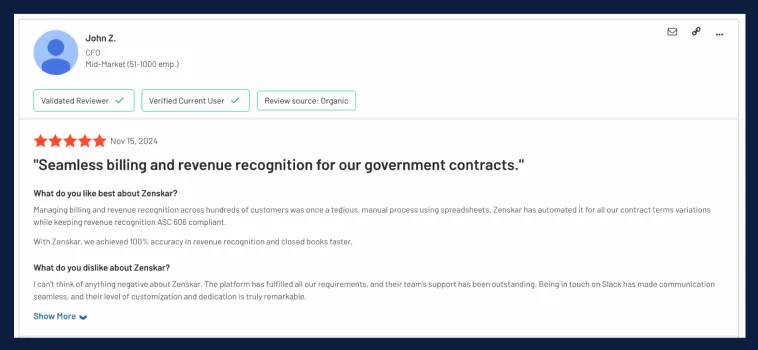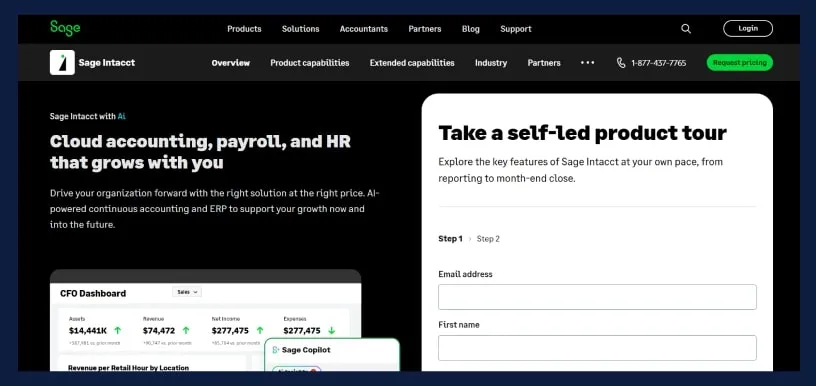
Top 5 Ordway Platform Alternatives
Explore 5 market-leading Ordway Platform alternatives. Compare pricing, features, and integrations to choose the best fit for your business needs.
Introduction
Ordway is a cloud-based platform that helps SaaS businesses manage usage and subscription billing, revenue recognition, and metrics reporting. Founded in 2018, the company set out to build a flexible billing system for companies looking to innovate their pricing and contract strategies. Most users recommend the platform for its customer support, billing management, flexibility, and automation. However, some common complaints include issues with billing, error handling, bugs, and complex implementation.

To help businesses evaluate alternatives, we compared the Ordway Platform to several industry-leading competitors. This guide covers Maxio, Zenskar, Zuora, Chargebee, and Sage Intacct. Some are full-fledged ERP solutions, while others focus specifically on billing automation, subscription management, revenue automation, or accounting. Each platform offers unique strengths and limitations. This comparison highlights those differences through the lens of billing automation, revenue recognition, and SaaS metrics reporting.
Here is a comparison of all 5 businesses before deep diving into a 1:1 comparison.

Top 5 Ordway Platform competitors deep dive one-to-one
Ordway Platform vs Maxio (SaaSOptics/Chargify)
When looking at Maxio vs Ordway Platform, you’re essentially comparing Ordway with the merged capabilities of SaaSOptics and Chargify, which are now unified as Maxio. Maxio positions itself as a financial operations platform for B2B SaaS companies, combining subscription billing (from Chargify) with subscription analytics and SaaS metrics (from SaaSOptics)
This means Maxio automates billing and payments and provides robust reporting on MRR/ARR, churn, cohorts, and revenue recognition for SaaS businesses. While strong in billing automation and revenue recognition, Ordway does not natively provide the same level of in-depth SaaS metric tracking – it focuses on the billing and revenue process between CRM and accounting. Maxio is a great Ordway alternative for B2B SaaS firms that want an integrated billing + analytics solution (and have finance teams keen on detailed SaaS KPIs). However, Maxio’s broader scope can introduce complexity; Ordway might appeal if you want a leaner billing system to plug into an existing analytics stack or prefer a more straightforward UI.

Key highlights and selection criteria
- Integrated SaaS analytics: A standout feature of Maxio (formerly SaaSOptics) is its built-in financial analytics for SaaS – e.g., tracking monthly recurring revenue, customer lifetime value, churn rates, deferred revenue, etc., all drawn from your billing data. Ordway does provide dashboards for billing and collections, but for detailed SaaS metrics, you’d rely on external BI or accounting tools. If having one unified system for billing and SaaS KPIs is a priority, Maxio offers that; otherwise, Ordway plus a separate analytics tool can suffice.
- Financial operations scope: Beyond billing, Maxio handles automated revenue and expense recognition and even budgeting to some extent. Ordway focuses on order-to-invoice-to-revenue, sitting between CRM and the general ledger. Companies aiming to consolidate billing and financial management (and maybe replace spreadsheets for SaaS metrics) might lean toward Maxio. Those who just need billing automation might prefer Ordway..
- Customer profile: Maxio’s customer base primarily consists of B2B SaaS companies, often those scaling revenue. Ordway’s users also include SaaS firms, but they can extend to subscription or usage-based billing (including IoT, services, etc.) in the SMB range.
- Implementation: Maxio, a combination of two platforms, has a more involved implementation (especially if migrating from separate systems or consolidating data). It offers single sign-on access to all billing and financial data in one place. Ordway implementation typically involves connecting it with your CRM and accounting – a focused integration. If you want a one-stop solution and are willing to undergo a potentially complex setup for the benefit of unified data, Maxio fits. If you prefer modular systems, Ordway allows you to keep billing modular.
Pricing: Maxio pricing starts at around $7K/year and upwards with custom quotes reflecting its value to growth-stage SaaS companies. Ordway’s custom pricing might scale with usage, but could be negotiated lower if you only need certain functionality.
Ordway Vs Maxio

Ordway Platform vs Zenskar

Zenskar and Ordway are modern usage-based billing software platforms that support recurring and hybrid billing models. Still, they differ in who they target as customers and their depth of capabilities. Ordway is best applied for scaling SMBs that require billing automation between CRM and accounting systems, particularly for SaaS and services. In contrast, Zenskar is designed to meet the needs of mid-sized to large enterprises seeking to manage hybrid pricing models, automate revenue recognition, and run multi-entity global operations. With support for billing models like usage-based, subscription-based, and hybrid billing combined with real-time, in-depth analytics, Zenskar is a strong Ordway alternative for organizations that desire deep flexibility and control.

Key highlights and selection criteria
- Billing flexibility: Ordway supports billing based on subscription and usage. Zenskar takes it further, enabling project-based, event-based, milestone-based, custom contracts, and hybrid billing models. These are perfect for businesses that combine recurring and project-based revenue.
- Invoicing automation and customization: Features for customization and automation; Zenskar differentiates itself with powerful invoicing capabilities, including manual edits, branded invoices, multi-language support, versioning, and history. Ordway supports invoice automation, but not as many customization layers are available out of the box.
- Revenue recognition: Both platforms allow compliance with ASC 606 and IFRS 15. However, Zenskar takes revenue recognition a step further by decoupling RevRec from billing, which can be particularly useful for companies that need flexibility with revenue recognition rules.
- Financial reporting and insights: Zenskar offers real-time reporting on usage trends, revenue reports, and product adoption metrics. The out-of-the-box dashboards are also customizable according to business requirements. Ordway focuses more on collections, revenue, and billing performance dashboards, which are great for finance teams, but less on the nitty-gritty operational product metrics.
- Integrations: Ordway connects with 50+ tools, such as Salesforce, QuickBooks, Stripe, and Avalara. Zenskar integrates with top ERPs, payment gateways, CRM, Data Warehouses, and an additional 100 through the open-source connector. It also provides a robust API for complex tech stacks or custom integrations.
- Multi-Entity + Multi-Currency: Both platforms support global operations, but Zenskar has the edge on transaction support across 100+ currencies and entity-level configurations. This is critical for businesses that are looking to expand globally or have existing global operations.
- Customer support and experience: Zenskar provides email, chat, Zoom, documentation, and onboarding support. Ordway offers 24/7 support through chat, email, and a knowledge base, which is adequate for most SMBs.
Why is Zenskar the best Ordway alternative?

Ordway Platform vs Zuora
Comparing Zuora vs. Ordway Platform pits an enterprise-grade subscription management suite against a mid-market billing automation tool. Zuora is often considered the leading solution for established enterprises transitioning to subscription models. It offers highly customizable billing cycles, a robust rating engine, and an extensive integration ecosystem, making it ideal for large-scale implementations. Ordway, in contrast, targets scaling businesses that need flexibility in billing without the complexity of an enterprise system. Ordway provides core subscription billing, usage tracking, and revenue recognition in a more user-friendly package. In contrast, Zuora delivers upper-market features (like built-in CPQ, multi-entity hierarchy, and advanced metrics) but at a premium cost and complexity. In short, Zuora suits large enterprises with sophisticated billing needs and the resources to support a heavy-duty platform. At the same time, Ordway serves SMBs and mid-market companies seeking agile billing automation with quicker implementation.

Key highlights and selection criteria
- Target market and scale: Zuora is built for large enterprises and high-growth companies. It’s frequently used by Fortune 500s and companies with complex subscription offerings across many customers or products. Ordway targets small to mid-market firms, offering needed scalability but focusing on simplicity for companies typically under a few million in ARR. If you need enterprise-grade scalability (e.g., thousands of subscribers, complex account hierarchies), Zuora is a leading choice; if you’re a smaller business, Zuora might be overkill, and Ordway could be a better fit.
- Features: Zuora provides end-to-end subscription lifecycle management – product catalog, quotes, billing, usage rating, payments, tax, and even an add-on module for revenue recognition (Zuora Revenue) for ASC 606 compliance. Ordway covers recurring billing, usage billing, dunning, and revenue recognition. Zuora often edges ahead in specialized features like multi-tier pricing configuration, complex discounting, and native CPQ integration.
- Integration ecosystem: Both platforms integrate with CRM, payment gateways, and ERP systems. Zuora has numerous integrations (Salesforce, Netsuite, Oracle, tax engines, etc.) and a robust API, aligning with big-company tech stacks. Ordway also offers APIs and integrations (Salesforce, QuickBooks, Xero, Stripe, Avalara, etc) but with leaner connectors.
- Implementation and ease of use: Zuora has a steep learning curve; enterprise users often require dedicated developers or Zuora experts to configure and maintain it. Ordway prides itself on a more user-centric design that finance and operations teams can manage without heavy IT involvement. Ordway may have an advantage for fast deployment and ease of use; for a long-term, highly customized solution, Zuora’s complexity may pay off.
- Cost: Zuora is custom-priced (usually a significant subscription cost plus possible volume-based fees) and generally more expensive. Ordway’s pricing is also custom but tailored to SMB budgets. If budget is an important constraint, Ordway or other alternatives might be preferable. Only opt for Zuora after considering the total cost of ownership (license, implementation, ongoing management) and ensuring your business volume justifies it.
Ordway Vs Zuora

Ordway Platform vs Chargebee
Chargebee is a leading recurring billing and revenue management solution for SMB and mid-market companies. It is known for its user-friendly interface and quick setup for subscription billing. It supports features like automated dunning and a self-service customer portal. Ordway similarly automates recurring invoicing, usage charges, and revenue recognition. Still, while Chargebee offers a more polished self-serve experience, Ordway offers highly customizable billing workflows tailored to complex B2B models. Chargebee is an excellent Ordway alternative for high-growth startups and mid-size SaaS companies seeking a turnkey billing solution with broad integrations. In contrast, Ordway may appeal to those needing deeper financial integration (sitting between CRM and ERP) and custom usage billing configurations as they scale.

Key highlights and selection criteria
- Market & Company size: Both Ordway and Chargebee serve growing subscription businesses. Chargebee targets small, mid-market, and even enterprise SaaS/e-commerce businesses. Ordway’s sweet spot also scales B2B companies, especially those with usage-based and subscription-based billing. If you’re a startup just establishing billing, Chargebee’s lower entry barrier and self-serve platform is attractive; if your business is already at scale with complex billing models and broken existing systems, Ordway’s tailored approach might fit better.
- Ease of implementation: Chargebee is often praised for being plug-and-play – you can configure product pricing and go live relatively quickly with minimal coding. It provides hosted checkout pages, a customer portal, and out-of-the-box email workflows for invoicing and payments. Ordway may require more configuration regarding integration with your CRM and accounting, but it offers flexibility for custom billing schedules and rules. If speed and simplicity are top priorities, Chargebee has an edge.
- Features and flexibility: Both platforms support recurring billing, coupons, proration, and essential revenue recognition. Chargebee also offers built-in subscription analytics and churn metrics. Ordway’s advantage is often in handling complex contract billing scenarios (e.g., combining recurring, one-off, and usage charges on one invoice) without requiring external workarounds. Companies with straightforward subscription models might not need Ordway’s extra flexibility, making Chargebee sufficient.
- Integrations: Chargebee boasts 50+ integrations (Salesforce, Xero, HubSpot, TaxJar, payment gateways, etc.) plus a well-documented API, which is beneficial for connecting to your tech stack. Ordway’s integration list is smaller but covers key systems (Salesforce, QuickBooks, Xero, NetSuite, Stripe, Avalara). Chargebee likely has an integration if you need one. In contrast, with Ordway, you might use its API for less common tools.
- Cost and pricing model: Chargebee offers tiered pricing with annual commitments and overage fees beyond a revenue cap. Ordway’s pricing is custom, often quoted based on your billing volume/requirements. Chargebee’s transparent plans can be appealing to early-stage companies watching budgets. Ordway will negotiate pricing for more significant deals where you want a tailored contract.
Ordway Vs Chargebee

Ordway Platform vs Sage Intacct
Sage Intacct is a cloud-based financial management solution for mid-to-large enterprises that need robust accounting, budgeting, and multi-entity financial operations. In contrast, Ordway focuses on automating subscription and usage-based billing.
Ordway excels in automating billing and revenue recognition, while Sage Intacct offers AI-powered automated accounts payable workflows, general ledger capabilities that detect anomalies, and extensive financial reporting. When considering Sage Intacct vs. Ordway, note that Sage Intacct can manage end-to-end finance (accounts receivable, accounts payable, etc.) but may be more complex to implement and costly for smaller teams. In contrast, Ordway delivers a lighter, specialized billing platform for rapidly scaling subscription businesses.

Key highlights and selection criteria
- Accounting vs. Billing focus: Sage Intacct provides a full suite of accounting and ERP modules (GL, AP, AR, multi-entity consolidations), which is ideal for companies outgrowing essential accounting software. On the other hand, Ordway specializes in billing automation and revenue recognition, assuming you’ll integrate with an external accounting system for general ledger needs. Choose Sage Intacct if you need an all-in-one financial system; choose Ordway if you already have accounting software (e.g., QuickBooks or Xero) and need advanced billing automation.
- Financial reporting: Sage Intacct offers comprehensive real-time financial dashboards and GAAP-compliant reports (P&L, balance sheet, cash flow) within the platform. Ordway provides billing-centric revenue and collections metrics reporting, but not complete financial statements. If audit-ready financial reports are a deal breaker, Sage Intacct has an edge.
- Billing & Subscription management: Ordway automates recurring invoicing, usage-based billing, and revenue recognition in one system. Sage Intacct also has subscription billing capabilities, but typically has less out-of-the-box flexibility for hybrid usage pricing compared to Ordway’s purpose-built billing engine.
- Cost considerations: Sage Intacct is sold via quote-based, per-user licensing (with no public pricing) and is known for a higher price tag commensurate with its enterprise capabilities. Ordway’s pricing is custom-based on usage/complexity. For organizations with>$5M in revenue and multiple users in finance, Sage Intacct’s cost may be justifiable; smaller teams focused solely on billing might find Ordway more cost-effective.
Ordway Vs Sage Intacct

Conclusion: Choosing the right Ordway alternative
Which alternative to the Ordway Platform best fits your business needs will depend on your business size, your industry, and whether you need strong billing, accounting, or support for end-to-end financial operations. The Ordway platform is adept at bridging the gap for scaling companies needing sophisticated billing automation but not a complete ERP. If you need a broader financial management system, Sage Intacct will be worth considering. For enterprises operating with a hybrid pricing model, it's advisable to look towards Zenskar, Maxio, and Zuora, while SMB-focused firms will usually price out with solutions such as Chargebee. Based on the comparison of the key features and our research around customer experiences shared in this guide, you can determine which Ordway alternative fits your business needs and growth goals. Each has strengths, and the best option will keep your billing and revenue processes humming and power your company’s scalable success.
If you’re looking for an all-in-one solution that automates billing and rev rec for all your pricing models and seamlessly integrates with your tech stack, Zenskar is the way to go.
Learn more about Zenskar’s suite of offerings, or take a demo to discover everything Zenskar has to offer.
Frequently asked questions
Everything you need to know about the product and billing. Can’t find what you are looking for? Please chat with our friendly team/Detailed documentation is here.
Ordway supports only subscription and usage-based pricing. If you're looking for a platform that's highly flexible and can handle hybrid pricing along with subscription and usage-based pricing, then check out Zenskar.
It allows for invoicing and collection in major international currencies, such as USD, CAD, GBP, EUR, CHF, and AUD.
The platform provides insights on recurring revenue, new bookings, expansions and contractions, net dollar retention, and customer counts.
There are limited pre-built integrations with popular accounting, ERP, CRM, tax, and payment gateways. Businesses can use their API for additional third-party integrations.
















